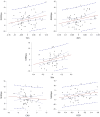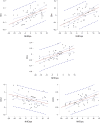Impact of Nordic hamstring breaking point angle on football player performance
- PMID: 40292093
- PMCID: PMC12032959
- DOI: 10.7717/peerj.19275
Impact of Nordic hamstring breaking point angle on football player performance
Abstract
Background: Football demands both aerobic and anaerobic capacities due to its dynamic movements, which include jumps, directional changes, ball control, and sprints. The Nordic hamstring exercise (NHE) enhances eccentric strength, which is crucial for high-intensity movements. However, the relationship between Nordic breaking point angle (NHEbpa), which is associated with eccentric hamstring peak torque during Nordic hamstring exercise, and sprint, countermovement jump (CMJ), and change of direction (COD) speed in soccer players has not been sufficiently investigated.
Objective: This analysis examines the relationship between the Nordic breaking point angle and critical performance indicators-sprint speed, COD ability, and vertical jump-in football players.
Methods: Fifty-eight male soccer players volunteered for the study. Assessments included anthropometric measurements, CMJ tests, 10-20-30 m sprint tests, and COD (zig-zag) tests. NHEbpa was measured using motion analysis software. Correlation analysis was used to determine the relationship between variables. A multiple linear regression analysis was conducted to evaluate the individual effects of the sprint, CMJ, and COD performances on NHEbpa, with data analyzed using JASP 0.18.
Results: Correlation analysis showed strong positive correlations between NHEbpa and sprint performances (r = 0.633 to 0.666), moderate negative correlation between NHEbpa and CMJ (r = -0.406), and moderate positive correlation between NHEbpa and COD (r = 0.580). Regression analysis results were used to analyze the independent coefficients of multiple variables more comprehensively, revealing significant predictors for performance: 20-m sprint (β = 24.166, p = 0.030), 10-m sprint (β = 22.564, p = 0.047), 30-m sprint (β = 10.677, p = 0.027), and CMJ (β = 4.974, p = 0.034). Conversely, COD performance (β = -0.154, p = 0.470) did not demonstrate a significant effect.
Conclusions: The study identified significant relationships between NHEbpa and sprint/CMJ performances (p < 0.05), while no meaningful effect was observed for COD speed (p > 0.05). These findings highlight the importance of eccentric strength in sprint performance, suggesting that other factors may play a more prominent role in COD. Incorporating eccentric-focused training, particularly through Nordic exercises, is recommended to enhance sprint performance and hamstring strength, which are essential for football players.
Keywords: Change of direction; Hamstring muscle strength; Nordic Hamstring breaking point angle; Performance in football players.
© 2025 Koç et al.
Conflict of interest statement
The authors declare that they have no competing interests.
Figures



Similar articles
-
Sprint and jump performance in elite male soccer players following a 10-week Nordic Hamstring exercise Protocol: a randomised pilot study.BMC Res Notes. 2017 Dec 4;10(1):669. doi: 10.1186/s13104-017-2986-x. BMC Res Notes. 2017. PMID: 29202784 Free PMC article.
-
Effects of the Nordic Hamstring exercise on sprint capacity in male football players: a randomized controlled trial.J Sports Sci. 2018 Jul;36(14):1663-1672. doi: 10.1080/02640414.2017.1409609. Epub 2017 Dec 1. J Sports Sci. 2018. PMID: 29192837 Clinical Trial.
-
Field based lower limb strength tests provide insight into sprint and change of direction ability in academy footballers.Scand J Med Sci Sports. 2021 Dec;31(12):2178-2186. doi: 10.1111/sms.14039. Epub 2021 Aug 30. Scand J Med Sci Sports. 2021. PMID: 34418145
-
The effects of the Nordic hamstring exercise on sprint performance and eccentric knee flexor strength: A systematic review and meta-analysis of intervention studies among team sport players.J Sci Med Sport. 2021 Sep;24(9):931-938. doi: 10.1016/j.jsams.2021.03.009. Epub 2021 Mar 22. J Sci Med Sport. 2021. PMID: 33893033
-
Effects of speed, agility, and quickness (SAQ) training on soccer player performance-a systematic review and meta-analysis.PLoS One. 2025 Feb 21;20(2):e0316846. doi: 10.1371/journal.pone.0316846. eCollection 2025. PLoS One. 2025. PMID: 39983087 Free PMC article.
References
-
- Adıgüzel NS, Koç M, Öztürk B, Engin H, Karaçam A, Canlı U, Orhan BE, Aldhahi MI. The effect of the nordic hamstring curl training program on athletic performance in young football players. Applied Sciences. 2024;14(22):10249. doi: 10.3390/app142210249. - DOI
-
- Ayala F, Robles-Palazón FJ, Blázquez-Rincón D, López-Valenciano A, López-López JA, De Ste Croix M. A systematic review and network meta-analysis on the effectiveness of exercise-based interventions for reducing the injury incidence in youth team-sport players. Part 2: an analysis by movement patterns. Annals of Medicine. 2024;56(1):2337724. doi: 10.1080/07853890.2024.2337724. - DOI - PMC - PubMed
-
- Bautista IJ, Vicente-Mampel J, Baraja-Vegas L, Segarra V, Martín F, Van Hooren B. The effects of the Nordic hamstring exercise on sprint performance and eccentric knee flexor strength: a systematic review and meta-analysis of intervention studies among team sport players. Journal of Science and Medicine in Sport. 2021;24(9):931–938. doi: 10.1016/j.jsams.2021.03.009. - DOI - PubMed
MeSH terms
LinkOut - more resources
Full Text Sources
Miscellaneous

